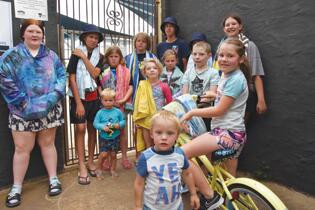General News
10 September, 2024
Future of community assets: challenging conversations
A NEW Loddon Shire strategy could force difficult decisions on the future of community infrastructure. The social infrastructure document was not imposing outcomes on the community but “certainly flagging that some difficult decisions may have to...

A NEW Loddon Shire strategy could force difficult decisions on the future of community infrastructure.
The social infrastructure document was not imposing outcomes on the community but “certainly flagging that some difficult decisions may have to be made”, Mayor Gavan Holt told last week’s council meeting.
However, he said those decisions would not be made without further consultation.
Tarnagulla Ward’s Linda Jung-wirth was the only councillor to vote against adoption of the strategy fearing facilities in smaller towns would miss out.
She said the strategy had too strong an emphasis on larger towns and services should be based on town needs not population.
“It’s a divisive method of reducing services and places too much importance on our large towns,” she said. “The Tarnagulla Ward is disproportionately impacted.”
Cr Jungwirth said Tarnagulla Ward had only small towns.
Wellbeing director Wendy Gladman said: “The social infrastructure Strategy provides a framework for how council can foster reasonable community access to social infrastructure across Loddon Shire. Social infrastructure includes, for example, facilities such as public halls, community centres, sports facilities and recreational spaces. “Whilst council acknowledges that these facilities support individuals, families, groups and communities to meet their social needs and enhance community wellbeing, it is also understood that there is an historic duplication of assets, many of whom are or will soon reach end of life, and influences a renewal gap that places increasing pressure on council’s long-term financial position,” Mrs Gladman said.
“The social infrastructure Strategy will provide the platform to start conversations with our community about the infrastructure that supports their social and health/wellbeing needs, the position that council faces in relation to the ability to adequately service the current social infrastructure offering and the future decisions that council will need to make to support long-term financial sustainability.”
The strategy says: “The larger towns in the Loddon Shire - ie Wedderburn, Inglewood, Bridgewater on Loddon, Boort, and Pyramid Hill - have a range of facilities and services, including health services and supermarkets, unavailable in the small towns. All localities in the Loddon Shire are within 30 minutes of drive time from at least one of the larger towns.
“Nearby towns ... several towns near the Loddon Shire offer facilities, goods, and services not available within the Shire or closer to some Loddon communities. The largest nearby town is Bendigo, a major regional centre offering many facilities and services. Almost 100 per cent of the Loddon Shire population can reach Bendigo within a 60-minute drive.”
The strategy lists current recreation spaces, more than 70 meeting places and other facilities in all Loddon towns.
“The population growth in urban centres does not indicate a need for additional social infrastructure ... there are multiple options available for the urban centres, including access to opportunities in nearby LGAs. The challenge is determining whether the existing social infrastructure assets meet the contemporary requirements and provide sufficient functionality, if there is an overlap in the availability of similar functionality, and if so, which facilities should be targeted for ongoing investment.
“Small towns accounted for less than 20 per cent of the population growth experienced in the Loddon Shire since the 2016 ABS Census.”
The strategy recommends three projects in the next year:
Identify the implications for the need or usage of town facilities based on the ROSA, Economic Development Strategy and Visitor Economy Strategy recommendations.
Develop a practical data collection process for the council, “management committees” and users to establish actual facility usage — both frequency and type. Collect usage data.
Complete asset assessments for all social infrastructure facilities that identify facilities that are at, or close to, end of life” and for which there are alternate spaces.
A three-year review of the shire’s community planning framework is proposed over three years to include a focus on identifying existing facilities that provide the most appropriate and usable indoor meeting space and spaces that are infrequently used (or not used at all).